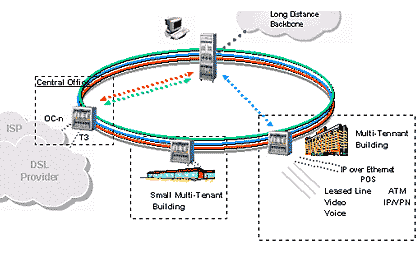Chromatis Scores Inaugural $25 Million Metro DWDM Contract With Cogent

Billed as the industry's first contract for metro dense wavelength division multiplexing (DWDM) products that integrate switching technology, Cogent Communications plans to purchase up to $25 million of metro DWDM systems from Chromatis Networks Inc. in a five-year deal. Cogent will deploy Chromatis' products in hundreds of multi-tenant buildings located in 13 major metropolitan areas throughout the U.S.
The Chromatis equipment will supplement that of Cisco—Cogent plans to deploy Cisco's ONS 15454 SONET add/drop multiplexers (ADMs) in access rings, ONS 15800 dense wavelength division multiplexing systems in its optical backbone, and 12016 GSR routers in major points of presence (see Figure 1).

Figure 1: Cogent plans to deploy Chromatis DWDM systems in major metro metro rings, along with Cisco's ONS 15454 SONET ADMs in access rings, 12016 GSR routers in major points-of-presence, and ONS 15800 in the core transport network. Backbone links will operate at 10 Gb/s.
In general, the Chromatis equipment will go on rings that support more than eight nodes and multiwavelength bandwidth, and the Cisco ADMs on smaller rings, explains Cogent CTO Brad Kummer. Cogent plans to turn up service in 800 office buildings—assuming an average of 10 buildings per ring, the deployment turns out to be about 80 rings, Kummer calculates.
Cogent has secured most of the fiber for its metro networks from Metromedia Fiber Network, building a single-fiber, bidirectional transmission architecture. "We're still in negotiations with dark fiber providers to provide dark fiber nationwide," Kummer reports, anticipating a deal in a few weeks.
Services
Cogent plans to provide clear-channel, non-blocking, non-oversubscribed 100 Mb/s data services to customers for about $1,000/month as an alternative to T-1 (1.5 Mb/s) services that price in at $1,500/month, according to Kummer. This model keeps Cogent's cost structure down and makes the most economic sense, Kummer reasons, while the Chromatis platform accommodates other services with little additional cost (see Figure 2).

Figure 2: Chromatis platform allows Cogent to provide 100 Mb/s Ethernet service and migrate to TDM and ATM services.
"Where appropriate, we can partner with other providers to make use of capacity to provide other services to customers," Kummer says. The Metropolis platform allows Cogent to combine other services with the 100 Mb/s units of Internet protocol (IP) traffic using the same wavelengths, and delivers wholesale carrier bandwidth DS-3 (45 Mb/s) or OC-n (155 Mb/s, 622 Mb/s, 2.5 Gb/s) circuits.
"You can think of it as a next-generation SONET box with much larger scale," says Chromatis VP of marketing Doug Green of Metropolis. With an aggregate switching capacity of 140 Gb/s, the 32-channel DWDM platform provides dual switch fabrics with 70 Gb/s of time division multiplexing (TDM) and 70 Gb/s of asynchronous transfer mode (ATM) switching. "You need a high-capacity switch fabric in there to make use of all the wavelengths," Green says.
To save money on optics, Chromatis designed nodes for the platform that don't use optics for sites that don't need the capacity. Given a wavelength, the Chromatis platform performs submultiplexing to aggregate TDM, IP, and ATM services running at relatively low rates onto the same wavelength. Although submultiplexing is emerging as conventional wisdom in metro optical networking, Green claims to have been there first. "We've been saying this for a year," he says.
On the management side, fault isolation, point-and-click provisioning, and unified operations round out the Metropolis feature set. One Chromatis customer with a three-layer network reports that it takes only 25% of the time to configure the Metropolis compared with an ATM switch, according to Green.
Equipment economics
The first-cost savings of using Metropolis versus a suite of traditional TDM, ATM, and IP transport equipment runs upwards of $1 million, Green calculates. Selective DWDM and submultiplexing technology yield another $200,000 or so of savings. That leaves the Chromatis customer with a start-up cost of less than $50,000 for a Metropolis node, Green concludes.
While Cogent is the first customer to come forward, Chromatis has two more trials underway with emerging competitive local exchange carriers (CLECs), and one underway with an incumbent LEC, Green reports. The vendor also has work scheduled with cable TV operators and long distance carriers.
Providing 100 Mb/s access is a sweet spot in the service provider business today that comes up short of providing wavelength services, or transparent optical pipes to customers that require tremendous bandwidth—an application that some thought would drive metro DWDM deployment, according to Green. "We do wavelength services, too," he says. "But the Catch-22 is that you have to justify deployments with revenue-generating service." Given that most end-users of communications bandwidth don't require wavelength-caliber bandwidth, wavelength services have not presented a compelling revenue opportunity, he reasons.
Chromatis has plenty of company in approaching metro optical networking with something besides transparent pipes. "We're at the maximum point of confusion in the market right now," Green surmises. "It will only clear up when customers start making decisions and buy." As for Chromatis' approach to entering the market, he says "the key to getting new technology adopted is not to disrupt what's there. You solve a problem in the existing network, then migrate to new services."
By Erik Kreifeldt
